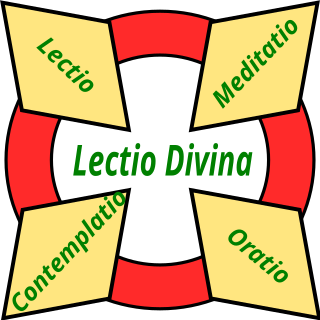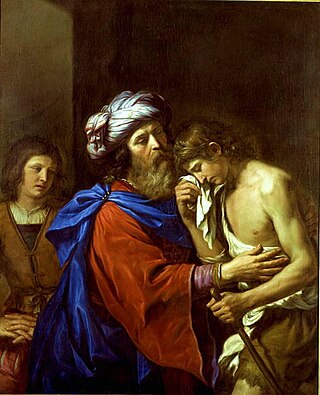Related Research Articles

Cyril of Jerusalem was a theologian of the Early Church. About the end of AD 350, he succeeded Maximus as Bishop of Jerusalem, but was exiled on more than one occasion due to the enmity of Acacius of Caesarea, and the policies of various emperors. Cyril left important writings documenting the instruction of catechumens and the order of the Liturgy in his day.

A sermon is a religious discourse or oration by a preacher, usually a member of clergy. Sermons address a scriptural, theological, or moral topic, usually expounding on a type of belief, law, or behavior within both past and present contexts. Elements of the sermon often include exposition, exhortation, and practical application. The act of delivering a sermon is called preaching. In secular usage, the word sermon may refer, often disparagingly, to a lecture on morals.

A catechism is a summary or exposition of doctrine and serves as a learning introduction to the Sacraments traditionally used in catechesis, or Christian religious teaching of children and adult converts. Catechisms are doctrinal manuals – often in the form of questions followed by answers to be memorised – a format that has been used in non-religious or secular contexts as well. According to Norman DeWitt, the early Christians appropriated this practice from the Epicureans, a school whose founder Epicurus had instructed to keep summaries of the teachings for easy learning. The term catechumen refers to the designated recipient of the catechetical work or instruction. In the Catholic Church, catechumens are those who are preparing to receive the Sacrament of Baptism. Traditionally, they would be placed separately during Holy Mass from those who had been baptized, and would be dismissed from the liturgical assembly before the Profession of Faith and General Intercessions.

The Montessori method of education is a type of educational method that involves children's natural interests and activities rather than formal teaching methods. A Montessori classroom places an emphasis on hands-on learning and developing real-world skills. It emphasizes independence and it views children as naturally eager for knowledge and capable of initiating learning in a sufficiently supportive and well-prepared learning environment. It discourages some conventional measures of achievement, such as grades and tests.
In Christian communities, Bible study is the study of the Bible by people as a personal religious or spiritual practice. In many Christian traditions, Bible study, coupled with Christian prayer, is known as doing devotions or devotional acts. Many Christian churches schedule time to engage in Bible study collectively. The origin of Bible study groups has its origin in early Christianity, when Church Fathers such as Origen and Jerome taught the Bible extensively to disciple Christians. In Christianity, Bible study has the purpose of "be[ing] taught and nourished by the Word of God" and "being formed and animated by the inspirational power conveyed by Scripture".
"The mystery of faith" and "a mystery of faith" are phrases found in different contexts and with a variety of meanings, either as translations of Greek τὸ μυστήριον τῆς πίστεως or Latin mysterium fidei, or as independent English phrases.

In Western Christianity, Lectio Divina is a traditional monastic practice of scriptural reading, meditation and prayer intended to promote communion with God and to increase the knowledge of God's word. In the view of one commentator, it does not treat Scripture as texts to be studied, but as the living word.

The parables of Jesus are found in the Synoptic Gospels and some of the non-canonical gospels. They form approximately one third of his recorded teachings. Christians place great emphasis on these parables, which they generally regard as the words of Jesus.

Catechesis is basic Christian religious education of children and adults, often from a catechism book. It started as education of converts to Christianity, but as the religion became institutionalized, catechesis was used for education of members who had been baptized as infants. As defined in the Catechism of the Catholic Church, paragraph 5 :
Catechesis is an education in the faith of children, young people and adults which includes especially the teaching of Christian doctrine imparted, generally speaking, in an organic and systematic way, with a view to initiating the hearers into the fullness of Christian life.

The Good Shepherd is an image used in the pericope of John 10:1–21, in which Jesus Christ is depicted as the Good Shepherd who lays down his life for his sheep. Similar imagery is used in Psalm 23 and Ezekiel 34:11–16. The Good Shepherd is also discussed in the other gospels, the Epistle to the Hebrews, the First Epistle of Peter and the Book of Revelation.
The Paschal mystery is one of the central concepts of Catholic theology relating to the history of salvation. According to the Compendium of the Catechism of the Catholic Church, "The Paschal Mystery of Jesus, which comprises his passion, death, resurrection, and glorification, stands at the center of the Christian faith because God's saving plan was accomplished once for all by the redemptive death of himself as Jesus Christ." The Catechism states that in the liturgy of the Church "it is principally his own Paschal mystery that Christ signifies and makes present."

Antonio Cañizares Llovera is a Spanish cardinal of the Roman Catholic Church who was the Archbishop of Valencia from 2014 to 2022. He was prefect of the Congregation for Divine Worship and the Discipline of the Sacraments from 2008 to 2014, and archbishop of Toledo and Primate of Spain from 2002 to 2008. He was made a cardinal in 2006.

The Gospel in Christian liturgy refers to a reading from the Gospels used during various religious services, including Mass or Divine Liturgy (Eucharist). In many Christian churches, all present stand when a passage from one of the Gospels is read publicly, and sit when a passage from a different part of the Bible is read. The reading of the Gospels, often contained in a liturgical edition containing only the four Gospels, is traditionally done by a minister, priest or deacon, and in many traditions the Gospel Book is brought into the midst of the congregation to be read.

A Chrismon tree is an evergreen tree often placed in the chancel or nave of a church during Advent and Christmastide. The Chrismon tree was first used by North American Lutherans in 1957, although the practice has spread to other Christian denominations, including Anglicans, Catholics, Methodists, and the Reformed. As with the ordinary Christmas tree, the evergreen tree itself, for Christians, "symbolizes the eternal life Jesus Christ provides". However, the Chrismon tree differs from the traditional Christmas tree in that it "is decorated only with clear lights and Chrismons made from white and gold material", the latter two being the liturgical colours of the Christmas season.
The Catholic University of America Press, also known as CUA Press, is the publishing division of The Catholic University of America. Founded on November 14, 1939, and incorporated on July 16, 1941, the CUA Press is a long-time member of the Association of University Presses. Its editorial offices are located on the campus of the Catholic University of America in Washington, D.C. The Press has over 1,000 titles in print and currently publishes 50-60 new titles annually, with particular emphasis on theology, philosophy, ecclesiastical history, medieval studies, and canon law. CUA Press distributes books on behalf of Sapientia Press of Ave Maria University, books of the Franciscan University of Steubenville Press, Humanum Academic Press of the John Paul II Institute, and for the Academy of American Franciscan History. CUA Press also publishes books under its Catholic Education Press imprint.
Raymond Alphonse Lucker was an American prelate of the Catholic Church. He served as bishop of the Diocese of New Ulm in Minnesota from 1976 to 2000. He previously served as an auxiliary bishop of the Archdiocese of St. Paul and Minneapolis from 1971 to 1976.

The Order of Christian Initiation of Adults (Latin: Ordo initiationis christianae adultorum), or OCIA, is a process developed by the Catholic Church for its catechumenate for prospective converts to the Catholic faith above the age of infant baptism. Candidates are gradually introduced to aspects of Catholic beliefs and practices. The basic process applies to adults and children who have reached catechetical age. In many English speaking countries, it is called Rite of Christian Initiation of Adults (RCIA). In the United States, the name was changed to the OCIA in 2021 to reflect greater fidelity to the original Latin, although this change has yet to be officially approved by the Dicastery for Divine Worship and the Discipline of the Sacraments.
Reformed worship is religious devotion to God as conducted by Reformed or Calvinistic Christians, including Presbyterians. Despite considerable local and national variation, public worship in most Reformed and Presbyterian churches is governed by the Regulative principle of worship.
Josef Andreas Jungmann was a prominent Jesuit priest and liturgist. He was an influential advocate of the Liturgical Movement, and is known for his 2-volume history Mass of the Roman Rite, which contributed to informing the reforms to the Mass during and following the Second Vatican Council, as well as his work in the post-Vatican II catechetical movement in the Catholic Church.
Godly Play is a Montessori method for Christian education. The method has been utilized in churches around the world.
References
- 1 2 "The CGS Approach". Catechesis of the Good Shepherd USA.
- ↑ "What is the Catechesis of the Good Shepherd?". St. Peter's Episcopal Church, Charlotte, NC.
- 1 2 "Co-founder of Catechesis of the Good Shepherd dies". The Catholic Sun.
- 1 2 John W. Martens. "Catechesis of the Good Shepherd Founder Sofia Cavalletti Dies". America Magazine.
- ↑ Scottie May. "Sofia Cavalletti". Talbot School of Theology.
- 1 2 Dr. Gerard O'Shea. "Catholic Education—A Road Map: The Work of Sofia Cavalletti, Catechesis of the Good Shepherd". Catechetical Review.
- 1 2 "Program seeks to guide children into personal, loving relationship with Christ". Southern Nebraska Register.
- ↑ "Sr. Evelyn Boyle (1932–2017) served as pioneer of Catechesis of the Good Shepherd". The Catholic Sun.
- 1 2 3 "Catechesis of the Good Shepherd: An Encounter with God". AD Today.
- ↑ James V. Brownson. "Sonja M. Stewart – An Appreciation". Western Theological Seminary.
- ↑ Victoria Schwartz. "The Theological Differences Between Godly Play and Catechesis of the Good Shepherd". Center for Children and Theology.